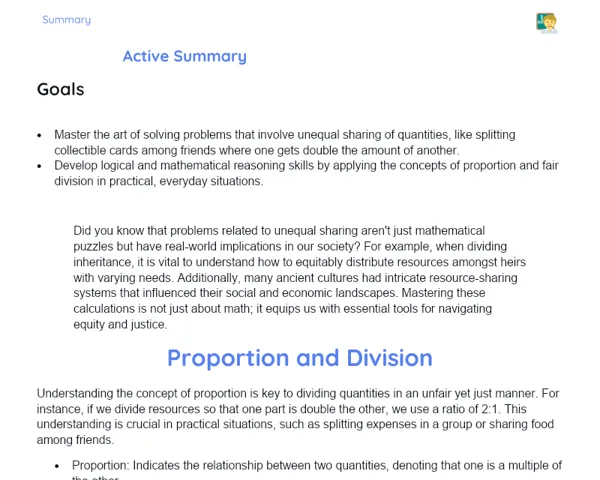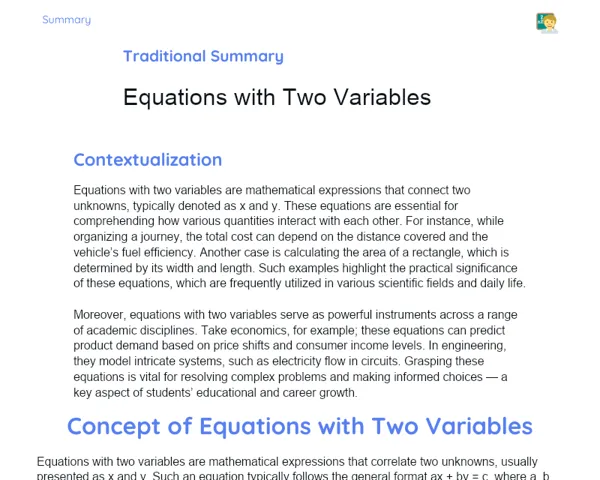Summary Tradisional | Clock Reading
Contextualization
Reading clocks is a vital skill that helps us manage our time and go about our day-to-day tasks. In our country, we commonly use both analog and digital clocks to track and record time. Mastering the art of reading both types of clocks is essential for managing our commitments, such as school hours, mealtimes, and leisure activities.
Analog clocks feature three main hands: the hour hand, the minute hand, and the second hand. Each hand serves a specific purpose in indicating time. The hour hand is the shortest and moves gradually, completing one full rotation every 12 hours. The minute hand is longer and moves faster, completing a rotation every 60 minutes. The second hand is the slimmest and moves continuously, completing a rotation every 60 seconds.
It's crucial to understand how to read both types of clocks for effective time management. In this lesson, we will examine the characteristics of each clock type and learn to accurately tell the time, appreciating the importance of this skill in our daily lives.
To Remember!
Identifying the Hands on an Analog Clock
Analog clocks have three main hands: the hour hand, the minute hand, and the second hand. Each hand functions differently and moves at varying speeds. The hour hand is the shortest and moves slowly, making a full rotation every 12 hours. The minute hand is longer and moves faster, completing its rotation every 60 minutes. The second hand is the thinnest, moving smoothly while completing a full rotation every 60 seconds.
To identify each hand accurately, pay attention to their length and positions. The hour hand shifts from one number to the next over the hour. The minute hand moves from one minute marker to another every minute. The second hand moves continuously, ticking off each passing second.
Recognizing each hand's function is essential for telling the correct time on an analog clock. By observing where each hand is pointing, you can accurately determine the hour, minutes, and seconds.
-
Hour hand: shortest, moves slowly, completes a rotation every 12 hours.
-
Minute hand: longer, moves more quickly, completes a rotation every 60 minutes.
-
Second hand: thinnest, moves continuously, completes a rotation every 60 seconds.
Reading Time on an Analog Clock
To tell the time on an analog clock, observe the positions of the three hands. The hour hand shows the current hour, the minute hand reveals how many minutes have passed since the last full hour, and the second hand indicates the seconds that have elapsed since the last full minute. For instance, if the hour hand is between 3 and 4 while the minute hand is at the 6, the time reads 3:30.
It's important to remember that the hour hand moves gradually throughout the day, and if it's positioned between two numbers, it signifies that the time falls within that range. The minute hand transitions perceptibly, with each numeral on the clock representing 5 minutes. The second hand gives a precise measure of seconds that have gone by.
Practicing reading the hours at various hand positions enhances the skill of accurately interpreting analog time. With practice, it becomes quicker and easier to determine the exact time, minutes, and seconds.
-
Observe the position of the hour, minute, and second hands.
-
The hour hand indicates the current hour; the minute hand shows the minutes passed since the last full hour.
-
Practicing reading the time at different hand positions helps develop interpretation skills.
Reading Time on a Digital Clock
Digital clocks present time in numerical format, making it easy to read directly. A digital clock typically displays four digits: the first two indicate the hours, while the last two denote the minutes. For instance, if a digital clock shows 14:30, it means it's two-thirty in the afternoon.
Reading a digital clock is straightforward and doesn’t involve interpreting any hands. The numbers are clearly visible, showing the exact hour and minutes. Some digital clocks also display seconds for more precise timekeeping.
Becoming adept at reading digital clocks is beneficial in various everyday scenarios, like checking the time on your mobile phone, digital devices, or smart wall clocks. The clarity and simplicity of digital clocks make reading them quick and efficient.
-
Digital clocks show time in a numerical format.
-
The first two digits represent the hours; the last two signify the minutes.
-
Reading is straightforward and does not require hands interpretation.
Comparison Between Analog and Digital Clocks
Recognizing the differences between analog and digital clocks is crucial for developing the skill to read time on either clock type. Analog clocks involve interpreting hand positions, while digital clocks allow for a direct reading of numbers. Both variants come with their own advantages and disadvantages.
Analog clocks can help visualize the ongoing passage of time and are useful for understanding fractions of time, such as quarters and halves of an hour. They also hold aesthetic and traditional value. However, they may pose a challenge for those unfamiliar with reading hands.
Digital clocks, conversely, offer a quick and precise reading of the numbers, aiding immediate comprehension of the exact time. They are commonly found on electronic devices and are convenient for situations requiring precision. However, they don’t provide the same ongoing visualization of time's passage as analog clocks.
-
Analog clocks require interpreting the hands; digital clocks show direct number readings.
-
Analog clocks are beneficial for visualizing time's progression and understanding time fractions.
-
Digital clocks provide quick, precise readings and are widely used in electronic devices.
Key Terms
-
Analog Clock: A clock with hands that indicate hours, minutes, and seconds.
-
Digital Clock: A clock that displays time numerically.
-
Hour Hand: A short hand showing the current hour on an analog clock.
-
Minute Hand: A longer hand indicating the minutes passed since the last full hour.
-
Second Hand: A thin hand that moves continuously, marking the seconds elapsed.
-
Reading Time: The skill of interpreting and identifying the correct time on both analog and digital clocks.
Important Conclusions
Reading both analog and digital clocks is crucial for managing our time and executing our daily activities. Throughout the lesson, we explored how to identify the hour, minute, and second hands, along with learning to read time accurately on different kinds of clocks. Practicing these skills fosters a clearer understanding of time, aiding in better organization of daily tasks.
Grasping the differences between analog and digital clocks is essential, as each provides unique advantages. While analog clocks help in visualizing the continuous passage of time, digital clocks offer a quick and accurate way to read the exact time. Being proficient in reading both types allows us to adapt to various situations in our everyday lives.
The ability to tell time accurately is highly practical, assisting us in meeting school timings, attending events, and maintaining daily routines. By continuing to practice reading clocks and exploring different methods of time measurement, we will enhance students' knowledge and self-reliance, making them more organized and punctual.
Study Tips
-
Practice reading both analog and digital clocks at home by observing various times throughout the day.
-
Utilize apps or educational games that simulate clock reading to improve your skills in interpreting time.
-
Discuss with family and friends about the importance of knowing how to tell time and ask them to show you different clocks and times for practice.



